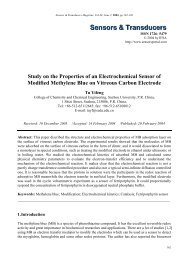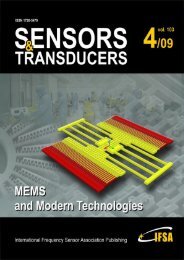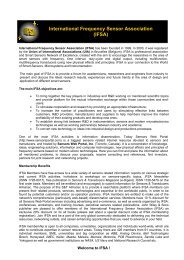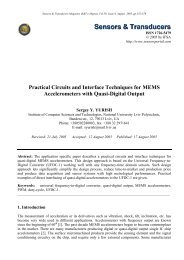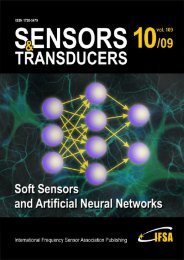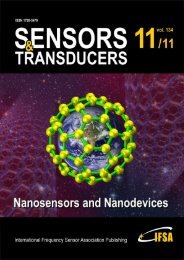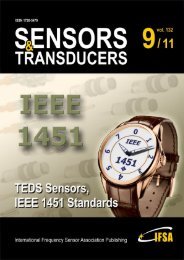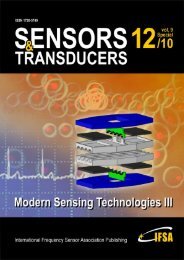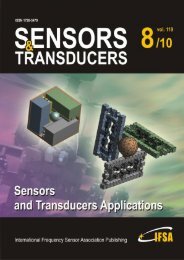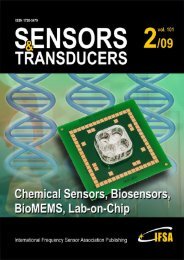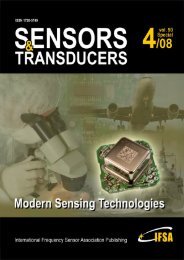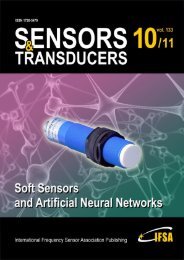Simple Synthesis of ZnCo2O4 Nanoparticles as Gas-sensing Materials
Simple Synthesis of ZnCo2O4 Nanoparticles as Gas-sensing Materials
Simple Synthesis of ZnCo2O4 Nanoparticles as Gas-sensing Materials
Create successful ePaper yourself
Turn your PDF publications into a flip-book with our unique Google optimized e-Paper software.
Sensors & Transducers<br />
Volume 134 Issue 11<br />
November 2011<br />
www.sensorsportal.com ISSN 1726-5479<br />
Editors-in-Chief: pr<strong>of</strong>essor Sergey Y. Yurish, tel.: +34 696067716, e-mail: editor@sensorsportal.com<br />
Editors for Western Europe<br />
Meijer, Gerard C.M., Delft University <strong>of</strong> Technology, The Netherlands<br />
Ferrari, Vittorio, Universitá di Brescia, Italy<br />
Editor for E<strong>as</strong>tern Europe<br />
Sachenko, Anatoly, Ternopil State Economic University, Ukraine<br />
Editors for North America<br />
Datskos, Panos G., Oak Ridge National Laboratory, USA<br />
Fabien, J. Josse, Marquette University, USA<br />
Katz, Evgeny, Clarkson University, USA<br />
Editor South America<br />
Costa-Felix, Rodrigo, Inmetro, Brazil<br />
Editor for Africa<br />
Maki K.Habib, American University in Cairo, Egypt<br />
Editor for Asia<br />
Ohyama, Shinji, Tokyo Institute <strong>of</strong> Technology, Japan<br />
Editor for Asia-Pacific<br />
Mukhopadhyay, Subh<strong>as</strong>, M<strong>as</strong>sey University, New Zealand<br />
Editorial Advisory Board<br />
Abdul Rahim, Ruzairi, Universiti Teknologi, Malaysia<br />
Ahmad, Mohd Noor, Nothern University <strong>of</strong> Engineering, Malaysia<br />
Annamalai, Karthigeyan, National Institute <strong>of</strong> Advanced Industrial Science<br />
and Technology, Japan<br />
Arcega, Francisco, University <strong>of</strong> Zaragoza, Spain<br />
Arguel, Philippe, CNRS, France<br />
Ahn, Jae-Pyoung, Korea Institute <strong>of</strong> Science and Technology, Korea<br />
Arndt, Michael, Robert Bosch GmbH, Germany<br />
Ascoli, Giorgio, George M<strong>as</strong>on University, USA<br />
Atalay, Selcuk, Inonu University, Turkey<br />
Atghiaee, Ahmad, University <strong>of</strong> Tehran, Iran<br />
Augutis, Vygant<strong>as</strong>, Kaun<strong>as</strong> University <strong>of</strong> Technology, Lithuania<br />
Avachit, Patil Lalchand, North Mahar<strong>as</strong>htra University, India<br />
Ayesh, Aladdin, De Montfort University, UK<br />
Azamimi, Azian binti Abdullah, Universiti Malaysia Perlis, Malaysia<br />
Bahreyni, Behraad, University <strong>of</strong> Manitoba, Canada<br />
Baliga, Shankar, B., General Monitors Transnational, USA<br />
Baoxian, Ye, Zhengzhou University, China<br />
Barford, Lee, Agilent Laboratories, USA<br />
Barlingay, Ravindra, RF Arrays Systems, India<br />
B<strong>as</strong>u, Sukumar, Jadavpur University, India<br />
Beck, Stephen, University <strong>of</strong> Sheffield, UK<br />
Ben Bouzid, Sihem, Institut National de Recherche Scientifique, Tunisia<br />
Benachaiba, Chellali, Universitaire de Bechar, Algeria<br />
Binnie, T. David, Napier University, UK<br />
Bisch<strong>of</strong>f, Gerlinde, Inst. Analytical Chemistry, Germany<br />
Bod<strong>as</strong>, Dhananjay, IMTEK, Germany<br />
Borges Carval, Nuno, Universidade de Aveiro, Portugal<br />
Bousbia-Salah, Mounir, University <strong>of</strong> Annaba, Algeria<br />
Bouvet, Marcel, CNRS – UPMC, France<br />
Brudzewski, Kazimierz, Warsaw University <strong>of</strong> Technology, Poland<br />
Cai, Chenxin, Nanjing Normal University, China<br />
Cai, Qingyun, Hunan University, China<br />
Campanella, Luigi, University La Sapienza, Italy<br />
Carvalho, Vitor, Minho University, Portugal<br />
Cecelja, Franjo, Brunel University, London, UK<br />
Cerda Belmonte, Judith, Imperial College London, UK<br />
Chakrabarty, Chandan Kumar, Universiti Tenaga N<strong>as</strong>ional, Malaysia<br />
Chakravorty, Dipankar, Association for the Cultivation <strong>of</strong> Science, India<br />
Changhai, Ru, Harbin Engineering University, China<br />
Chaudhari, Gajanan, Shri Shivaji Science College, India<br />
Chavali, Murthy, N.I. Center for Higher Education, (N.I. University), India<br />
Chen, Jiming, Zhejiang University, China<br />
Chen, Rongshun, National Tsing Hua University, Taiwan<br />
Cheng, Kuo-Sheng, National Cheng Kung University, Taiwan<br />
Chiang, Jeffrey (Cheng-Ta), Industrial Technol. Research Institute, Taiwan<br />
Chiriac, Horia, National Institute <strong>of</strong> Research and Development, Romania<br />
Chowdhuri, Arijit, University <strong>of</strong> Delhi, India<br />
Chung, Wen-Yaw, Chung Yuan Christian University, Taiwan<br />
Corres, Jesus, Universidad Publica de Navarra, Spain<br />
Cortes, Camilo A., Universidad Nacional de Colombia, Colombia<br />
Courtois, Christian, Universite de Valenciennes, France<br />
Cusano, Andrea, University <strong>of</strong> Sannio, Italy<br />
D'Amico, Arnaldo, Università di Tor Vergata, Italy<br />
De Stefano, Luca, Institute for Microelectronics and Microsystem, Italy<br />
Deshmukh, Kiran, Shri Shivaji Mahavidyalaya, Barshi, India<br />
Dickert, Franz L., Vienna University, Austria<br />
Dieguez, Angel, University <strong>of</strong> Barcelona, Spain<br />
Dighavkar, C. G., M.G. Vidyamandir’s L. V.H. College, India<br />
Dimitropoulos, Panos, University <strong>of</strong> Thessaly, Greece<br />
Ko, Sang Choon, Electronics. and Telecom. Research Inst., Korea South<br />
Ding, Jianning, Jiangsu Polytechnic University, China<br />
Djordjevich, Alexandar, City University <strong>of</strong> Hong Kong, Hong Kong<br />
Donato, Nicola, University <strong>of</strong> Messina, Italy<br />
Donato, Patricio, Universidad de Mar del Plata, Argentina<br />
Dong, Feng, Tianjin University, China<br />
Drljaca, Predrag, Instersema Sensoric SA, Switzerland<br />
Dubey, Venketesh, Bournemouth University, UK<br />
Enderle, Stefan, Univ.<strong>of</strong> Ulm and KTB Mechatronics GmbH, Germany<br />
Erdem, Gursan K. Arzum, Ege University, Turkey<br />
Erkmen, Aydan M., Middle E<strong>as</strong>t Technical University, Turkey<br />
Estelle, Patrice, Insa Rennes, France<br />
Estrada, Horacio, University <strong>of</strong> North Carolina, USA<br />
Faiz, Adil, INSA Lyon, France<br />
Fericean, Sorin, Balluff GmbH, Germany<br />
Fernandes, Joana M., University <strong>of</strong> Porto, Portugal<br />
Francioso, Luca, CNR-IMM Institute for Microelectronics and Microsystems, Italy<br />
Francis, Laurent, University Catholique de Louvain, Belgium<br />
Fu, Weiling, South-Western Hospital, Chongqing, China<br />
Gaura, Elena, Coventry University, UK<br />
Geng, Yanfeng, China University <strong>of</strong> Petroleum, China<br />
Gole, James, Georgia Institute <strong>of</strong> Technology, USA<br />
Gong, Hao, National University <strong>of</strong> Singapore, Singapore<br />
Gonzalez de la Rosa, Juan Jose, University <strong>of</strong> Cadiz, Spain<br />
Granel, Annette, Goteborg University, Sweden<br />
Graff, M<strong>as</strong>on, The University <strong>of</strong> Tex<strong>as</strong> at Arlington, USA<br />
Guan, Shan, E<strong>as</strong>tman Kodak, USA<br />
Guillet, Bruno, University <strong>of</strong> Caen, France<br />
Guo, Zhen, New Jersey Institute <strong>of</strong> Technology, USA<br />
Gupta, Narendra Kumar, Napier University, UK<br />
Hadjilouc<strong>as</strong>, Sill<strong>as</strong>, The University <strong>of</strong> Reading, UK<br />
Haider, Mohammad R., Sonoma State University, USA<br />
H<strong>as</strong>hsham, Syed, Michigan State University, USA<br />
H<strong>as</strong>ni, Abdelhafid, Bechar University, Algeria<br />
Hernandez, Alvaro, University <strong>of</strong> Alcala, Spain<br />
Hernandez, Wilmar, Universidad Politecnica de Madrid, Spain<br />
Homentcovschi, Dorel, SUNY Binghamton, USA<br />
Horstman, Tom, U.S. Automation Group, LLC, USA<br />
Hsiai, Tzung (John), University <strong>of</strong> Southern California, USA<br />
Huang, Jeng-Sheng, Chung Yuan Christian University, Taiwan<br />
Huang, Star, National Tsing Hua University, Taiwan<br />
Huang, Wei, PSG Design Center, USA<br />
Hui, David, University <strong>of</strong> New Orleans, USA<br />
Jaffrezic-Renault, Nicole, Ecole Centrale de Lyon, France<br />
Jaime Calvo-Galleg, Jaime, Universidad de Salamanca, Spain<br />
James, Daniel, Griffith University, Australia<br />
Janting, Jakob, DELTA Danish Electronics, Denmark<br />
Jiang, Liudi, University <strong>of</strong> Southampton, UK<br />
Jiang, Wei, University <strong>of</strong> Virginia, USA<br />
Jiao, Zheng, Shanghai University, China<br />
John, Joachim, IMEC, Belgium<br />
Kalach, Andrew, Voronezh Institute <strong>of</strong> Ministry <strong>of</strong> Interior, Russia<br />
Kang, Moonho, Sunmoon University, Korea South<br />
Kanius<strong>as</strong>, Eugenijus, Vienna University <strong>of</strong> Technology, Austria<br />
Katake, Anup, Tex<strong>as</strong> A&M University, USA<br />
Kausel, Wilfried, University <strong>of</strong> Music, Vienna, Austria<br />
Kav<strong>as</strong>oglu, Nese, Mugla University, Turkey<br />
Ke, Cathy, Tyndall National Institute, Ireland<br />
Khelfaoui, Rachid, Université de Bechar, Algeria<br />
Khan, Asif, Aligarh Muslim University, Aligarh, India<br />
Kim, Min Young, Kyungpook National University, Korea South<br />
Sandacci, Serghei, Sensor Technology Ltd., UK
Kotulska, Malgorzata, Wroclaw University <strong>of</strong> Technology, Poland<br />
Kockar, Hakan, Balikesir University, Turkey<br />
Kong, Ing, RMIT University, Australia<br />
Kratz, Henrik, Uppsala University, Sweden<br />
Krishnamoorthy, Ganesh, University <strong>of</strong> Tex<strong>as</strong> at Austin, USA<br />
Kumar, Arun, University <strong>of</strong> South Florida, USA<br />
Kumar, Subodh, National Physical Laboratory, India<br />
Kung, Chih-Hsien, Chang-Jung Christian University, Taiwan<br />
Lacnjevac, C<strong>as</strong>lav, University <strong>of</strong> Belgrade, Serbia<br />
Lay-Ekuakille, Aime, University <strong>of</strong> Lecce, Italy<br />
Lee, Jang Myung, Pusan National University, Korea South<br />
Lee, Jun Su, Amkor Technology, Inc. South Korea<br />
Lei, Hua, National Starch and Chemical Company, USA<br />
Li, Fengyuan (Thom<strong>as</strong>), Purdue University, USA<br />
Li, Genxi, Nanjing University, China<br />
Li, Hui, Shanghai Jiaotong University, China<br />
Li, Xian-Fang, Central South University, China<br />
Li, Yuefa, Wayne State University, USA<br />
Liang, Yuanchang, University <strong>of</strong> W<strong>as</strong>hington, USA<br />
Liawruangrath, Saisunee, Chiang Mai University, Thailand<br />
Liew, Kim Meow, City University <strong>of</strong> Hong Kong, Hong Kong<br />
Lin, Hermann, National Kaohsiung University, Taiwan<br />
Lin, Paul, Cleveland State University, USA<br />
Linderholm, Pontus, EPFL - Microsystems Laboratory, Switzerland<br />
Liu, Aihua, University <strong>of</strong> Oklahoma, USA<br />
Liu Changgeng, Louisiana State University, USA<br />
Liu, Cheng-Hsien, National Tsing Hua University, Taiwan<br />
Liu, Songqin, Southe<strong>as</strong>t University, China<br />
Lodeiro, Carlos, University <strong>of</strong> Vigo, Spain<br />
Lorenzo, Maria Encarnacio, Universidad Autonoma de Madrid, Spain<br />
Luk<strong>as</strong>zewicz, Jerzy Pawel, Nichol<strong>as</strong> Copernicus University, Poland<br />
Ma, Zhanfang, Northe<strong>as</strong>t Normal University, China<br />
Majstorovic, Vidosav, University <strong>of</strong> Belgrade, Serbia<br />
Malyshev, V.V., National Research Centre ‘Kurchatov Institute’, Russia<br />
Marquez, Alfredo, Centro de Investigacion en Materiales Avanzados, Mexico<br />
Matay, Ladislav, Slovak Academy <strong>of</strong> Sciences, Slovakia<br />
Mathur, Prafull, National Physical Laboratory, India<br />
Maurya, D.K., Institute <strong>of</strong> <strong>Materials</strong> Research and Engineering, Singapore<br />
Mekid, Samir, University <strong>of</strong> Manchester, UK<br />
Melnyk, Ivan, Photon Control Inc., Canada<br />
Mendes, Paulo, University <strong>of</strong> Minho, Portugal<br />
Mennell, Julie, Northumbria University, UK<br />
Mi, Bin, Boston Scientific Corporation, USA<br />
Min<strong>as</strong>, Graca, University <strong>of</strong> Minho, Portugal<br />
Moghavvemi, Mahmoud, University <strong>of</strong> Malaya, Malaysia<br />
Mohammadi, Mohammad-Reza, University <strong>of</strong> Cambridge, UK<br />
Molina Flores, Esteban, Benemérita Universidad Autónoma de Puebla,<br />
Mexico<br />
Moradi, Majid, University <strong>of</strong> Kerman, Iran<br />
Morello, Rosario, University "Mediterranea" <strong>of</strong> Reggio Calabria, Italy<br />
Mounir, Ben Ali, University <strong>of</strong> Sousse, Tunisia<br />
Mrad, Nezih, Defence R&D, Canada<br />
Mulla, Imtiaz Sirajuddin, National Chemical Laboratory, Pune, India<br />
Nabok, Aleksey, Sheffield Hallam University, UK<br />
Neelamegam, Peri<strong>as</strong>amy, S<strong>as</strong>tra Deemed University, India<br />
Neshkova, Milka, Bulgarian Academy <strong>of</strong> Sciences, Bulgaria<br />
Oberhammer, Joachim, Royal Institute <strong>of</strong> Technology, Sweden<br />
Ould Lahoucine, Cherif, University <strong>of</strong> Guelma, Algeria<br />
Pamidighanta, Sayanu, Bharat Electronics Limited (BEL), India<br />
Pan, Jisheng, Institute <strong>of</strong> <strong>Materials</strong> Research & Engineering, Singapore<br />
Park, Joon-Shik, Korea Electronics Technology Institute, Korea South<br />
Penza, Michele, ENEA C.R., Italy<br />
Pereira, Jose Miguel, Instituto Politecnico de Setebal, Portugal<br />
Petsev, Dimiter, University <strong>of</strong> New Mexico, USA<br />
Pogacnik, Lea, University <strong>of</strong> Ljubljana, Slovenia<br />
Post, Michael, National Research Council, Canada<br />
Prance, Robert, University <strong>of</strong> Sussex, UK<br />
Pr<strong>as</strong>ad, Ambika, Gulbarga University, India<br />
Prateep<strong>as</strong>en, Asa, Kingmoungut's University <strong>of</strong> Technology, Thailand<br />
Pullini, Daniele, Centro Ricerche FIAT, Italy<br />
Pumera, Martin, National Institute for <strong>Materials</strong> Science, Japan<br />
Radhakrishnan, S. National Chemical Laboratory, Pune, India<br />
Rajanna, K., Indian Institute <strong>of</strong> Science, India<br />
Ramadan, Q<strong>as</strong>em, Institute <strong>of</strong> Microelectronics, Singapore<br />
Rao, B<strong>as</strong>uthkar, Tata Inst. <strong>of</strong> Fundamental Research, India<br />
Rao<strong>of</strong>, Kosai, Joseph Fourier University <strong>of</strong> Grenoble, France<br />
R<strong>as</strong>togi Shiva, K. University <strong>of</strong> Idaho, USA<br />
Reig, Candid, University <strong>of</strong> Valencia, Spain<br />
Restivo, Maria Teresa, University <strong>of</strong> Porto, Portugal<br />
Robert, Michel, University Henri Poincare, France<br />
Rezazadeh, Ghader, Urmia University, Iran<br />
Royo, Santiago, Universitat Politecnica de Catalunya, Spain<br />
Rodriguez, Angel, Universidad Politecnica de Cataluna, Spain<br />
Rothberg, Steve, Loughborough University, UK<br />
Sadana, Ajit, University <strong>of</strong> Mississippi, USA<br />
Sadeghian Marnani, Hamed, TU Delft, The Netherlands<br />
Sapozhnikova, Ksenia, D.I.Mendeleyev Institute for Metrology, Russia<br />
Saxena, Vibha, Bhbha Atomic Research Centre, Mumbai, India<br />
Schneider, John K., Ultra-Scan Corporation, USA<br />
Sengupta, Deepak, Advance Bio-Photonics, India<br />
Seif, Selemani, Alabama A & M University, USA<br />
Seifter, Achim, Los Alamos National Laboratory, USA<br />
Shah, Kriyang, La Trobe University, Australia<br />
Sankarraj, Anand, Detector Electronics Corp., USA<br />
Silva Girao, Pedro, Technical University <strong>of</strong> Lisbon, Portugal<br />
Singh, V. R., National Physical Laboratory, India<br />
Slomovitz, Daniel, UTE, Uruguay<br />
Smith, Martin, Open University, UK<br />
Soleymanpour, Ahmad, Damghan B<strong>as</strong>ic Science University, Iran<br />
Somani, Prak<strong>as</strong>h R., Centre for <strong>Materials</strong> for Electronics Technol., India<br />
Sriniv<strong>as</strong>, Talabattula, Indian Institute <strong>of</strong> Science, Bangalore, India<br />
Sriv<strong>as</strong>tava, Arvind K., NanoSonix Inc., USA<br />
Stefan-van Staden, Raluca-Ioana, University <strong>of</strong> Pretoria, South Africa<br />
Stefanescu, Dan Mihai, Romanian Me<strong>as</strong>urement Society, Romania<br />
Sumriddetchka, Sarun, National Electronics and Computer Technology Center,<br />
Thailand<br />
Sun, Chengliang, Polytechnic University, Hong-Kong<br />
Sun, Dongming, Jilin University, China<br />
Sun, Junhua, Beijing University <strong>of</strong> Aeronautics and Astronautics, China<br />
Sun, Zhiqiang, Central South University, China<br />
Suri, C. Raman, Institute <strong>of</strong> Microbial Technology, India<br />
Sysoev, Victor, Saratov State Technical University, Russia<br />
Szewczyk, Roman, Industrial Research Inst. for Automation and Me<strong>as</strong>urement,<br />
Poland<br />
Tan, Ooi Kiang, Nanyang Technological University, Singapore,<br />
Tang, Dianping, Southwest University, China<br />
Tang, Jaw-Luen, National Chung Cheng University, Taiwan<br />
Teker, K<strong>as</strong>if, Frostburg State University, USA<br />
Thirunavukkar<strong>as</strong>u, I., Manipal University Karnataka, India<br />
Thumbavanam Pad, Kartik, Carnegie Mellon University, USA<br />
Tian, Gui Yun, University <strong>of</strong> Newc<strong>as</strong>tle, UK<br />
Tsiantos, V<strong>as</strong>silios, Technological Educational Institute <strong>of</strong> Kaval, Greece<br />
Tsigara, Anna, National Hellenic Research Foundation, Greece<br />
Twomey, Karen, University College Cork, Ireland<br />
Valente, Antonio, University, Vila Real, - U.T.A.D., Portugal<br />
Vanga, Raghav Rao, Summit Technology Services, Inc., USA<br />
V<strong>as</strong>e<strong>as</strong>hta, Ashok, Marshall University, USA<br />
Vazquez, Carmen, Carlos III University in Madrid, Spain<br />
Vieira, Manuela, Instituto Superior de Engenharia de Lisboa, Portugal<br />
Vigna, Benedetto, STMicroelectronics, Italy<br />
Vrba, Radimir, Brno University <strong>of</strong> Technology, Czech Republic<br />
Wandelt, Barbara, Technical University <strong>of</strong> Lodz, Poland<br />
Wang, Jiangping, Xi'an Shiyou University, China<br />
Wang, Kedong, Beihang University, China<br />
Wang, Liang, Pacific Northwest National Laboratory, USA<br />
Wang, Mi, University <strong>of</strong> Leeds, UK<br />
Wang, Shinn-Fwu, Ching Yun University, Taiwan<br />
Wang, Wei-Chih, University <strong>of</strong> W<strong>as</strong>hington, USA<br />
Wang, Wensheng, University <strong>of</strong> Pennsylvania, USA<br />
Watson, Steven, Center for NanoSpace Technologies Inc., USA<br />
Weiping, Yan, Dalian University <strong>of</strong> Technology, China<br />
Wells, Stephen, Southern Company Services, USA<br />
Wolkenberg, Andrzej, Institute <strong>of</strong> Electron Technology, Poland<br />
Woods, R. Clive, Louisiana State University, USA<br />
Wu, DerHo, National Pingtung Univ. <strong>of</strong> Science and Technology, Taiwan<br />
Wu, Zhaoyang, Hunan University, China<br />
Xiu Tao, Ge, Chuzhou University, China<br />
Xu, Lisheng, The Chinese University <strong>of</strong> Hong Kong, Hong Kong<br />
Xu, Sen, Drexel University, USA<br />
Xu, Tao, University <strong>of</strong> California, Irvine, USA<br />
Yang, Dongfang, National Research Council, Canada<br />
Yang, Shuang-Hua, Loughborough University, UK<br />
Yang, Wuqiang, The University <strong>of</strong> Manchester, UK<br />
Yang, Xiaoling, University <strong>of</strong> Georgia, Athens, GA, USA<br />
Yaping Dan, Harvard University, USA<br />
Ymeti, Aurel, University <strong>of</strong> Twente, Netherland<br />
Yong Zhao, Northe<strong>as</strong>tern University, China<br />
Yu, Haihu, Wuhan University <strong>of</strong> Technology, China<br />
Yuan, Yong, M<strong>as</strong>sey University, New Zealand<br />
Yufera Garcia, Alberto, Seville University, Spain<br />
Zakaria, Zulkarnay, University Malaysia Perlis, Malaysia<br />
Zagnoni, Michele, University <strong>of</strong> Southampton, UK<br />
Zamani, Cyrus, Universitat de Barcelona, Spain<br />
Zeni, Luigi, Second University <strong>of</strong> Naples, Italy<br />
Zhang, Minglong, Shanghai University, China<br />
Zhang, Qintao, University <strong>of</strong> California at Berkeley, USA<br />
Zhang, Weiping, Shanghai Jiao Tong University, China<br />
Zhang, Wenming, Shanghai Jiao Tong University, China<br />
Zhang, Xueji, World Precision Instruments, Inc., USA<br />
Zhong, Haoxiang, Henan Normal University, China<br />
Zhu, Qing, Fujifilm Dimatix, Inc., USA<br />
Zorzano, Luis, Universidad de La Rioja, Spain<br />
Zourob, Mohammed, University <strong>of</strong> Cambridge, UK<br />
Sensors & Transducers Journal (ISSN 1726-5479) is a peer review international journal published monthly online by International Frequency Sensor Association (IFSA).<br />
Available in electronic and on CD. Copyright © 2011 by International Frequency Sensor Association. All rights reserved.
Sensors & Transducers Journal<br />
Contents<br />
Volume 134<br />
Issue 11<br />
November 2011<br />
www.sensorsportal.com ISSN 1726-5479<br />
Research Articles<br />
Nanomaterials and Chemical Sensors<br />
Sukumar B<strong>as</strong>u and Pal<strong>as</strong>h Kumar B<strong>as</strong>u ............................................................................................ 1<br />
Fabrication <strong>of</strong> Phenyl-Hydrazine Chemical Sensor B<strong>as</strong>ed on Al- doped ZnO <strong>Nanoparticles</strong><br />
Mohammed M. Rahman, Sher Bahadar Khan, A. Jamal, M. Faisal, Abdullah M. Asiri ..................... 32<br />
Nanostructured Ferrite B<strong>as</strong>ed Electronic nose Sensitive to Ammonia at room temperature<br />
U. B. Gaw<strong>as</strong>, V. M. S. Verenkar, D. R. Patil....................................................................................... 45<br />
A Humidity Sensor B<strong>as</strong>ed on Nb-doped Nanoporous TiO 2 Thin Film<br />
Mansoor Anbia, S. E. Moosavi Fard................................................................................................... 56<br />
A Resistive Humidity Sensor B<strong>as</strong>ed on Nanostructured WO 3 -ZnO Composites<br />
Karunesh Tiwari, Anupam Tripathi, N. K. Pandey.............................................................................. 65<br />
Highly Sensitive Cadmium Concentration Sensor Using Long Period Grating<br />
A. S. Lal<strong>as</strong>angi, J. F. Akki, K. G. Manohar, T. Sriniv<strong>as</strong>, Pr<strong>as</strong>ad Raikar, Sanjay Kher<br />
and U. S. Raikar ................................................................................................................................. 76<br />
MEMS B<strong>as</strong>ed Ethanol Sensor Using ZnO Nanoblocks, Nanocombs and Nan<strong>of</strong>lakes <strong>as</strong><br />
Sensing Layer<br />
H. J. Pandya, Sudhir Chandra and A. L. Vy<strong>as</strong> ................................................................................... 85<br />
<strong>Simple</strong> <strong>Synthesis</strong> <strong>of</strong> ZnCo 2 O 4 <strong>Nanoparticles</strong> <strong>as</strong> G<strong>as</strong>-<strong>sensing</strong> <strong>Materials</strong><br />
S. V. Bangale,S. M. Khetre D. R. Patil and S. R. Bamane................................................................. 95<br />
Nanostructured Spinel ZnFe 2 O 4 for the Detection <strong>of</strong> Chlorine G<strong>as</strong><br />
S. V. Bangale, D. R. Patil and S. R. Bamane..................................................................................... 107<br />
Fabrication <strong>of</strong> Polyaniline-ZnO Nanocomposite G<strong>as</strong> Sensor<br />
S. L. Patil, M. A. Chougule, S. G. Pawar, Sh<strong>as</strong>hwati Sen, A. V. Moholkar, J. H. Kim and V. B. Patil 120<br />
<strong>Synthesis</strong> and Characterization <strong>of</strong> Nano-Crystalline Cu and Pb 0.5 -Cu 0.5 - ferrites by<br />
Mechanochemical Method and Their Electrical and G<strong>as</strong> Sensing Properties<br />
V. B. Gaikwad ,S. S. Gaikwad, A. V. Borhade and R. D. Nikam........................................................ 132<br />
Surface Modification <strong>of</strong> MWCNTs: Preparation, Characterization and Electrical Percolation<br />
Studies <strong>of</strong> MWCNTs/PVP Composite Films for Realization <strong>of</strong> Ammonia G<strong>as</strong> Sensor<br />
Operable at Room Temperature<br />
Sakshi Sharma, K. Sengupta, S. S. Islam.......................................................................................... 143<br />
An Investigation <strong>of</strong> Structural and Electrical Properties <strong>of</strong> Nano Crystalline SnO2: Cu Thin<br />
Films Deposited by Spray Pyrolysis<br />
J. Podder and S. S. Roy ..................................................................................................................... 155
Nanocrystalline Cobalt-doped SnO2 Thin Film: A Sensitive Cigarette Smoke Sensor<br />
Patil Shriram B., More Mahendra A., Patil Arun V.............................................................................. 163<br />
Effect <strong>of</strong> Annealing on the Structural and Optical Properties <strong>of</strong> Nano Fiber ZnO Films<br />
Deposited by Spray Pyrolysis<br />
M. R. Islam, J. Podder, S. F. U. Farhad and D. K. Saha.................................................................... 170<br />
Amperometric Acetylcholinester<strong>as</strong>e Biosensor B<strong>as</strong>ed on Multilayer Multiwall Carbon<br />
Nanotubes-chitosan Composite<br />
Xia Sun, Chen Zhai, Xiangyou Wang................................................................................................. 177<br />
Fabrication <strong>of</strong> Biosensors B<strong>as</strong>ed on Nanostructured Conducting Polyaniline (NSPANI)<br />
Deepshikha Saini, Ruchika Chauhan and Tinku B<strong>as</strong>u....................................................................... 187<br />
Authors are encouraged to submit article in MS Word (doc) and Acrobat (pdf) formats by e-mail: editor@sensorsportal.com<br />
Ple<strong>as</strong>e visit journal’s webpage with preparation instructions: http://www.sensorsportal.com/HTML/DIGEST/Submition.htm<br />
International Frequency Sensor Association (IFSA).
Sensors & Transducers Journal, Vol. 134, Issue 11, November 2011, pp. 95-106<br />
Sensors & Transducers<br />
ISSN 1726-5479<br />
© 2011 by IFSA<br />
http://www.sensorsportal.com<br />
<strong>Simple</strong> <strong>Synthesis</strong> <strong>of</strong> ZnCo 2 O 4 <strong>Nanoparticles</strong><br />
<strong>as</strong> G<strong>as</strong>-<strong>sensing</strong> <strong>Materials</strong><br />
*<br />
S. V. Bangale, * S. M. Khetre ** D. R. Patil and * S. R. Bamane<br />
*<br />
Metal Oxide Research, Laboratory, Department <strong>of</strong> Chemistry, Dr. Patangrao Kadam<br />
Mahavidyalaya, Sangli 416416 (M.S.) India<br />
**<br />
Bulk and Nano <strong>Materials</strong> Research Lab, Dept. <strong>of</strong> Physics, Rani Laxmibai College<br />
Parola, Dist – Jalgaon, 425111<br />
Tel.: 0233-2535993, fax: 0233-2535993<br />
E-mail: bangale_sv@rediffmail.com<br />
Received: 15 July 2011 /Accepted: 21 November 2011 /Published: 29 November 2011<br />
Abstract: Semiconductive nanometer-size material ZnCo 2 O 4 w<strong>as</strong> synthesized by a solution combustion<br />
reaction <strong>of</strong> inorganic reagents <strong>of</strong> Zn(NO 3 ) 3 . 6H 2 O, Co(NO 3 ) 3 .6H 2 O and glycine <strong>as</strong> a fuel. The process w<strong>as</strong><br />
a convenient, environment friendly, inexpensive and efficient preparation method for the ZnCo 2 O 4<br />
nanomaterial. The synthesized materials were characterized by TG/DTA, XRD, EDX, SEM, and TEM.<br />
Conductance responses <strong>of</strong> the nanocrystalline ZnCo 2 O 4 thick film were me<strong>as</strong>ured by exposing the film to<br />
reducing g<strong>as</strong>es like Acetone, Ethanol, Ammonia (NH 3 ), Hydrogen (H 2 ), Hydrogen sulphide (H 2 S),<br />
Chlorine (Cl 2 ) and Liquefied petroleum g<strong>as</strong> (LPG). It w<strong>as</strong> found that the sensors exhibited various<br />
<strong>sensing</strong> responses to these g<strong>as</strong>es at different operating temperature. Furthermore, the sensor exhibited a<br />
f<strong>as</strong>t response and a good recovery. The results demonstrated that ZnCo 2 O 4 can be used <strong>as</strong> a new type <strong>of</strong><br />
g<strong>as</strong>-<strong>sensing</strong> material which h<strong>as</strong> a high sensitivity and good selectivity to Liquefied petroleum g<strong>as</strong> (LPG)<br />
at 100 ppm. Copyright © 2011 IFSA.<br />
Keyword: Nanostructure ZnCo 2 O 4 , XRD, SEM, TEM, G<strong>as</strong> sensor.<br />
1. Introduction<br />
Among the various materials, ZnO is the most promising semiconductor [1] to detect the toxic and<br />
hazardous g<strong>as</strong>es. In recent years, one dimensional (1D) nanostructures <strong>of</strong> semiconducting metal oxides<br />
with high surface to volume ratio and small grain size have received focused attention due to their<br />
95
Sensors & Transducers Journal, Vol. 134, Issue 11, November 2011, pp. 95-106<br />
potential applications in fabricating g<strong>as</strong> sensors [2, 5], humidity sensors [6, 7] and nanoelectronic circuits<br />
[9]. Cr2O3-activated ZnO w<strong>as</strong> reported to be a humidity sensors [10], Cr2O3-modified ZnO thick film<br />
resistors w<strong>as</strong> reported to be LPG sensors [11]. Liquefied petroleum g<strong>as</strong> (LPG) is utilized in almost every<br />
kitchen all over the world. It is therefore, referred <strong>as</strong> a town g<strong>as</strong> or cooking g<strong>as</strong>. It is utilized in large<br />
extent for industrial purposes and in laboratories <strong>as</strong> fuel. Cooking g<strong>as</strong> consists chiefly <strong>of</strong> butane [12],<br />
which is a colourless and odourless g<strong>as</strong>. It is usually mixed with compounds <strong>of</strong> sulphur (viz.methyl<br />
mercaptan and ethyl mercaptan) having foul smell, so that its leakage can be noticed e<strong>as</strong>ily. This g<strong>as</strong> is<br />
potentially hazardous because explosion accidents [13] might be caused, when it leaks out by mistake. It<br />
h<strong>as</strong> been reported that, at the concentration up to noticeable leakage, it is very much more than the lower<br />
explosive limit (LEL) <strong>of</strong> the g<strong>as</strong> in air. Explosion accidents destroyed many industries, laboratories,<br />
kitchens and houses, building, societies and what not? Many researchers are working on LPG sensor, but<br />
could not meet the challenges up to the depth <strong>of</strong> demand by society. So there is a great demand from the<br />
society <strong>of</strong> detecting LPG for the purpose <strong>of</strong> safety application in domestic and industrial fields.<br />
Among p-type semiconducting metal oxide, Co 3 O 4 is a promising material due to its application potential<br />
in many technological are<strong>as</strong> such <strong>as</strong> heterogeneous catalysis [14], anode material in lithium rechargeable<br />
batteries [15], sensors [16], Zinc cobaltite ZnCo 2 O 4 is one <strong>of</strong> these compounds, which h<strong>as</strong> long been used<br />
<strong>as</strong> a ceramic color pigment or dying material [17,18]. In the same way, solid soluctions <strong>of</strong> nominal<br />
composition Zn x Co 3-x O 4 exhibit improved adsorbent capabilities so they find application <strong>as</strong> selective<br />
catalysts for oxidation and hydrogenation reaction [19], <strong>as</strong> well <strong>as</strong> for the monitoring and removal <strong>of</strong><br />
harmful species such <strong>as</strong> Cl 2 , NO 2 , CO 2 and H 2 S among others [20]. ZnCo 2 O 4 is a cobalt b<strong>as</strong>ed spinel<br />
oxide, where divalent Zn ions occupy the tetrahedral site in the cubic spinel structure and the trivalent Co<br />
ions occupy the octahedral site [21]. Different methods such <strong>as</strong> typical co-precipitation [22], sol-gel route<br />
[23], hydrothermal synthesis [24], high-temperature calcinations <strong>of</strong> hydroxide or carbonate precursor<br />
mixtures [25] and combustion method have been proposed recently and developed which make it possible<br />
to obtain spinel oxides in the form <strong>of</strong> ultrafine or nanoparticles. Chen and Coworkers [26] prepared by<br />
MCo 2 O 4 ( M = Ni, Cu, Zn) nanotubes by using template <strong>as</strong>sisted method and investigated their g<strong>as</strong><br />
<strong>sensing</strong> properties to Cl 2 , NO 2 , C 2 H 2 OH, SO 2 and CO. Du et al [27] synthesized ZnM 2 O 4 ( M = Fe, Co,<br />
Cr) by microemulsion method and studied the g<strong>as</strong> <strong>sensing</strong> properties to Cl 2 , NO 2 , C 2 H 5 OH, H 2 S and<br />
acetone. The aim <strong>of</strong> the present work is to develop LPG sensor by ZnCo 2 O 4 thick films. This could be<br />
able to detect the trace amount <strong>of</strong> LPG. It w<strong>as</strong> studied that the g<strong>as</strong> <strong>sensing</strong> performance <strong>of</strong> the material<br />
can be improved by incorporating few additives into the b<strong>as</strong>e material and/ or surface activation <strong>of</strong> thick<br />
films. Some well-known materials used for the fabrication <strong>of</strong> LPG sensor are SnO 2 [28], Ru-SnO 2 [29],<br />
modified-SnO 2 [30], etc.<br />
In the paper, we report a LPG sensor with g<strong>as</strong> response and good selectivity using cubic nanostructure<br />
ZnCo 2 O 4 <strong>as</strong> the <strong>sensing</strong> material for the first time. The nanostructure ZnCo 2 O 4 w<strong>as</strong> synthesized by<br />
combustion route first time using mixed precursor (consisting <strong>of</strong> zinc nitrate, magnesium nitrate and<br />
glycine) at 800 0 C in air for 4 h. The mixed precursor w<strong>as</strong> prepared through a low cost and simple<br />
combustion method.<br />
2. Experimental<br />
2.1. Powder Preparation<br />
In this study, the <strong>as</strong>-synthesized ZnCo 2 O 4 powder were prepared using combustion synthesis different<br />
molar composition <strong>of</strong> fuel, subsequently, the molar composition w<strong>as</strong> maintained constant, and process<br />
w<strong>as</strong> carried out under varying synthesis temperatures.<br />
Zinc cobalt oxide (ZnCo 2 O 4 ) w<strong>as</strong> synthesized using the modified solution combustion technique, starting<br />
from solution <strong>of</strong> Zn(NO 3 ) 2 6H 2 O (7.43g), (Co (NO 3 ) 2 6H 2 O (7.27g), and glycine (6.05g). glycine possesses<br />
96
Sensors & Transducers Journal, Vol. 134, Issue 11, November 2011, pp. 95-106<br />
a high heat <strong>of</strong> combustion. It is an organic fuel and providing a platform for redox reactions during the<br />
course <strong>of</strong> combustion. Initially the Zinc nitrates, Cobalt nitrates and Glycine are taken in the 1:1:4<br />
stoichiometric amount and dissolved in a 250 ml beaker and made in homogenous peste. Peste formed<br />
w<strong>as</strong> evaporated on hot plate in temperature range <strong>of</strong> 70 0 C to 80 0 C resulting into a thick gel. The gel w<strong>as</strong><br />
kept on a hot plate for auto combustion and heated in the temperature range <strong>of</strong> 170 0 C to 180 0 C. The<br />
nanocrystalline ZnCo 2 O 4 powder w<strong>as</strong> formed within a five minute. And it w<strong>as</strong> sintered at about 300, 500,<br />
800 and 1000 0 C for about 4 hours when we got a black color shining powder <strong>of</strong> nanocrystalline<br />
ZnCo 2 O 4.<br />
2.2. Thick Film Preparation<br />
Zinc cobalt oxide powder w<strong>as</strong> ground in an agate p<strong>as</strong>tel-moter to ensure sufficiently fine particle size.<br />
The fine powder w<strong>as</strong> calcined at 800 0 C for 24 h in air and re-ground. The thixotropic p<strong>as</strong>te [31, 32] w<strong>as</strong><br />
formulated by mixing the resulting ZnCo 2 O 4 fine powder with a soluction <strong>of</strong> ethyl cellulose (a temporary<br />
binder) in a mixture <strong>of</strong> organic solvents such <strong>as</strong> butyl carbitol acetate and turpineol. The ratio <strong>of</strong> inorganic<br />
and organic path w<strong>as</strong> kept <strong>as</strong> 75:25 in formulating the p<strong>as</strong>te. The p<strong>as</strong>te w<strong>as</strong> then used to prepare thick<br />
films. The thixotropic p<strong>as</strong>te w<strong>as</strong> screen printed on a gl<strong>as</strong>s substrate in desired patterns. The films prepared<br />
were fired at 500 0 C for 24 h.<br />
2.3. Characterization<br />
The <strong>as</strong> –prepared samples were characterized by TG/DTA thermal analyzer (SDT Q600 V 20.9 Build 20),<br />
XRD Philips Analytic X-ray B.V. (PW-3710 B<strong>as</strong>ed Model diffraction analysis using Cu-K α radiation),<br />
scanning electron microscope (SEM, JEOL JED 2300) coupled with an energy dispersive spectrometer<br />
(EDS JEOL 6360 LA), A JEOL JEM–200 CX transmission electron microscope operating at 200 kV<br />
analysis.<br />
3. Result and Discussion<br />
3.1 TG-DTA<br />
2C 2 NH 3 O 2 + (9/2) O 2 → N 2 + CO 2 + 5H 2 O (1)<br />
Zn (NO 3 ) 3 + Co (NO 3 ) 3 + 4C 2 H 5 NO 2 → ZnCo 2 O 4 + 8H 2 O + 10H 2 O + 5N 2 (2)<br />
TG-DTA analysis w<strong>as</strong> performed at a heating rate <strong>of</strong> 10 K min -1 to investigate the thermal properties <strong>of</strong><br />
ZnCo 2 O 4. The TG spectrum and its 1 st derivative in Fig. 1 show the thermal decomposition <strong>of</strong> ZnCo 2 O 4 is<br />
the curve indicates that the slight weight loss <strong>of</strong> about 13.2 % at temperature up to 140 0 C in ZnCo 2 O 4<br />
powder due to little loss <strong>of</strong> moisture, carbon dioxide and nitrogen g<strong>as</strong>. The DTA curve <strong>of</strong> ZnCo 2 O 4<br />
recorded in static air and in shown in Fig. 1. The curve shown that ZnCo 2 O 4 did not decompose, but<br />
weight loss w<strong>as</strong> due to dehydrogenation, decarboxylation and denitraction. Further weight loss <strong>of</strong> about<br />
28 % between the temperature range 300 0 C and continuous loss in weight about 48 % up to 600 0 C is<br />
attributed to loss <strong>of</strong> organic materials and yield final product at 650 0 C, this weight loss and weight gained<br />
w<strong>as</strong> very negligible. This weight change w<strong>as</strong> in the range <strong>of</strong> 650 0 C these indicating that the synthesized<br />
powder w<strong>as</strong> almost stable from the begging. The formation temperature in the present work is found to be<br />
comparatively similar than that reported for corresponding solid state reaction route [33].<br />
97
Sensors & Transducers Journal, Vol. 134, Issue 11, November 2011, pp. 95-106<br />
Fig. 1. TG-DTA curve <strong>of</strong> mixed precursorZnCo 2 O 4 .<br />
3.2. XRD Results<br />
The X-ray diffraction pattern <strong>of</strong> sample at different temperatures <strong>of</strong> synthesis. Is shown in Fig. 2. The<br />
observed d values compared with standard d values and are in good agreement with standard d value<br />
JCPDS data. (Card number 82-1042). The structure possesses the cubic may be attributed to the different<br />
preparation method which may yield different structural defects. The crystalline size w<strong>as</strong> determined<br />
from full width <strong>of</strong> half maximum (FWHM) <strong>of</strong> the most intense peak obtained by shown scanning <strong>of</strong><br />
X-ray diffraction pattern. The crystallite size w<strong>as</strong> calculated by using Scherrer equation [25-26]<br />
d = 0.9λ/ βcosθ,<br />
where, d is the crystalline size, λ is the X-ray wavelength <strong>of</strong> the Cu K α source (λ=1.54056 A 0 ), β is the<br />
FWHM <strong>of</strong> the most predominant peak at 100 % intensity, θ is the Braggs angle at which peak is recorded.<br />
In order to obtain pure nanocrystalline ZnCo 2 O 4 particles and understand the thermal characterizations,<br />
the <strong>as</strong> prepared ZnCo 2 O 4 powder is further calcined at 180, 300, 500, 800 and 1000 0 C respectively (the<br />
calcined temperature <strong>as</strong>signed <strong>as</strong> T C ). Fig. 2 presents XRD patterns for ZnCo 2 O 4 oxide nanoparticles. The<br />
effects <strong>of</strong> the calcinations temperature on the crystallite size <strong>of</strong> ZnCo 2 O 4 particles can be demonstrated.<br />
Traces <strong>of</strong> ZnCo 2 O 4 crystallites ph<strong>as</strong>es (111), (220), (311), (222), (400),(311), (422) and (511) are detected<br />
in the XRD pattern for all calcined temperatures and then their intensities incre<strong>as</strong>e abruptly when the T C<br />
above 1000 0 C .In general, the sharpness <strong>of</strong> the XRD peak (i.e. high crystallinity) is incre<strong>as</strong>ed <strong>as</strong> the T C<br />
incre<strong>as</strong>es. According to the (222) diffraction pattern <strong>of</strong> ZnCo 2 O 4 crystalline, the particle size <strong>of</strong> ZnCo 2 O 4<br />
can be calculated from the full width at haif-maximum using the Scherrer equation. Obviously, the<br />
particle size <strong>of</strong> ZnCo 2 O 4 changes <strong>as</strong> the Tc controlled fewer than 180, 300, 500, 800 and 1000 0 C, the<br />
order is 7, 8, 9, 12 and 37 nm, respectively.<br />
3.3. Particle Size Analyzer<br />
Particle size distribution studies Fig. 3 have been carried out by using dynamic light scattering techniques<br />
(DLS) via L<strong>as</strong>er input energy <strong>of</strong> 632 nm). It w<strong>as</strong> observed that zinc cobalt oxide nanoparticles particles<br />
have narrow size distribute within the range <strong>of</strong> about 25-30 nm. Which well matches are with calculated<br />
from Debye-Scherrer equation?<br />
98
Sensors & Transducers Journal, Vol. 134, Issue 11, November 2011, pp. 95-106<br />
Intensity (arbitary unit)<br />
111<br />
220<br />
222<br />
311<br />
1000 O C<br />
800 O C<br />
500 O C<br />
300 O C<br />
400<br />
331<br />
422<br />
511<br />
180 O C<br />
20 40 60 80 100<br />
Fig. 2. XRD pattern <strong>of</strong> calcinied mixed precursorZnCo 2 O 4 at 300 0 C, 500 0 C. 800 0 C, 1000 0 C in air for 4 h.<br />
2<br />
Fig. 3. Particle size Distribution <strong>of</strong> mixed precursor ZnCo 2 O 4 at 800 0 C in air for 4 h.<br />
3.4. Energy dispersive X-ray microanalysis studies (EDX)<br />
Fig. 4 shows the energy dispersive X-ray spectrum <strong>of</strong> ZnCo 2 O 4 . This w<strong>as</strong> carried out to understand the<br />
composition <strong>of</strong> zinc, cobalt and oxygen in the material. There w<strong>as</strong> no unidentified peak observed in EDX.<br />
This confirms the purity and the composition <strong>of</strong> the ZnCo 2 O 4 nanomaterial.<br />
3.5. Scanning Electron Micrograph Study<br />
The microstructure <strong>of</strong> the 800 0 C sintered samples can be visualized from scanning electron microscope<br />
(SEM) tool. Fig. 5. epicts SEM images <strong>of</strong> ZnCo 2 O 4 powder. Shown the partical morphology <strong>of</strong> high<br />
resolution, the partical are most irregular in shape with a nanosize range 100-200 nm some particles are<br />
found <strong>as</strong> agglomerations containing very fine particles. It can be observed that ZnCo 2 O 4 have uniformed<br />
size <strong>of</strong> about 5μm.It seems that surface are smooth, spongy pores are seen in the micrograph.<br />
99
Sensors & Transducers Journal, Vol. 134, Issue 11, November 2011, pp. 95-106<br />
Fig. 4. EDX pattern <strong>of</strong> mixed precursor ZnCo 2 O 4 at 800 0 C in air for 4 h.<br />
(a)<br />
(b)<br />
Fig. 5. SEM images <strong>of</strong> mixed precursor ZnCo 2 O 4 at 800 0 C in air for 4 h (a) low resolution, and (b) high resolution.<br />
3.6. Transmission Electron Microscopy (TEM)<br />
The TEM image <strong>of</strong> the mixed precursor calcined at 800 0 C for 4 h are shown in Fig. 6(a, b).It indicates<br />
the presence <strong>of</strong> ZnCo 2 O 4 nanoparticles with size 30-40 nm which form beed type <strong>of</strong> oriental aggregation<br />
throughout the region. The selected area electron diffraction (SAED) pattern Fig. 6 (c) shows the spot<br />
type pattern which is indicative <strong>of</strong> the presence <strong>of</strong> single crystalline particles. No evidence w<strong>as</strong> found for<br />
more than one pattern, suggesting the single phage nature <strong>of</strong> the material.<br />
3.7. Thickness Me<strong>as</strong>urement<br />
The thicknesses <strong>of</strong> the films were observed to be in the range from 25-35 µm. The reproducibility <strong>of</strong> the<br />
film thickness w<strong>as</strong> achieved by maintaining the proper rheology and thixotropy <strong>of</strong> the p<strong>as</strong>te.<br />
100
Sensors & Transducers Journal, Vol. 134, Issue 11, November 2011, pp. 95-106<br />
(a)<br />
(b)<br />
(c)<br />
Fig. 6. TEM (a, b) images <strong>of</strong> nanostructured ZnCo 2 O 4 (c) SAED pattern.<br />
4. Electrical Properties <strong>of</strong> the Sensors<br />
4.1 I-V Characteristics<br />
Fig. 7. depicts I-V characteristics <strong>of</strong> ZnCo 2 O 4 films. It is clear from the symmetrical I-V characteristics<br />
that the silver contacts on the films were ohmic in nature.<br />
4.2. Electrical Conductivity<br />
Fig. 8 shows the variation <strong>of</strong> log (conductivity) with temperature. The conductivity values <strong>of</strong> sample<br />
incre<strong>as</strong>e with operating temperature. The incre<strong>as</strong>e in conductivity with incre<strong>as</strong>ing temperature could be<br />
attributed to negative temperature coefficient <strong>of</strong> resistance and semiconducting nature <strong>of</strong> ZnCo 2 O 4 . It is<br />
observed from Fig. 8 that the electrical conductivities <strong>of</strong> the ZnCo 2 O 4 films are nearly linear in the<br />
temperature range from 50- 400 0 C in air ambient.<br />
101
Sensors & Transducers Journal, Vol. 134, Issue 11, November 2011, pp. 95-106<br />
Fig. 7. I-V characteristics <strong>of</strong> the sensor.<br />
Fig. 8. Variation log (conductivity) with reciprocal operating temperature (K -1 ).<br />
5. Sensing Performance <strong>of</strong> Sensor<br />
5.1 G<strong>as</strong> Response, Selectivity, Response and Recovery Time<br />
The relative response (S) to a target g<strong>as</strong> is defined <strong>as</strong> the ratio <strong>of</strong> the change in conductance <strong>of</strong> a sample<br />
upon exposure <strong>of</strong> the g<strong>as</strong> to the original conductance in air. The relation for S is given <strong>as</strong><br />
S = G g -G a /G a ,<br />
where G a is the conductance in air and G g the conductance in a sample g<strong>as</strong>.<br />
Specificity or selectivity is defined <strong>as</strong> the ability <strong>of</strong> a sensor to respond to a certain g<strong>as</strong> in the presence <strong>of</strong><br />
different g<strong>as</strong>es. Response time (RST) is defined <strong>as</strong> the time neede for a sensor to attain 90 % <strong>of</strong> the<br />
maximum incre<strong>as</strong>es in conductance on exposure to the target g<strong>as</strong>.<br />
Recovery time (RCT) is the time taken to get back 90 % <strong>of</strong> the original conductance in air.<br />
102
Sensors & Transducers Journal, Vol. 134, Issue 11, November 2011, pp. 95-106<br />
5.2. G<strong>as</strong> Response and Operating Temperature<br />
Fig. 9 depicts the variation <strong>of</strong> 100 ppm g<strong>as</strong> responses with operating temperature. The ZnCo 2 O 4 sensor<br />
w<strong>as</strong> observed to be a temperature dependents g<strong>as</strong> sensor. From Fig. 9, it is observed that the sensor better<br />
responds to LPG g<strong>as</strong> at 350 0 C, H 2 S g<strong>as</strong> at 300 0 C, Ethanol g<strong>as</strong> at 300 0 C Acetone g<strong>as</strong> at 300 0 C, NH 3 g<strong>as</strong><br />
at 300 0 C, CI 2 g<strong>as</strong> at 300 0 C, H 2 g<strong>as</strong> at 350 0 C, CO 2 g<strong>as</strong> at 250 0 C. The sensitivity towards such g<strong>as</strong><br />
depends on temperature. The same sensors could be used to identify LPG, H 2 S, Ethanol, Acetone, NH 3 ,<br />
Cl 2 , H 2 , and CO 2 just by varying the operating temperature. This is the most desirable characteristic <strong>of</strong><br />
this sensor.<br />
Fig. 9. Variation <strong>of</strong> different g<strong>as</strong> responses with operating temperatures.<br />
5.3. G<strong>as</strong> Response and G<strong>as</strong> Concentration<br />
It is observed from Fig. 10 that the response <strong>of</strong> ZnCo 2 O 4 film w<strong>as</strong> observed to incre<strong>as</strong>es continuously<br />
with incre<strong>as</strong>ing the g<strong>as</strong> concentration up to 100 ppm, and it attains the maximum and saturates above<br />
100 ppm. Therefore, the active region <strong>of</strong> the sensor would be up to 100 ppm, <strong>as</strong> the rate <strong>of</strong> rise <strong>of</strong><br />
response is larger during this region. At lower g<strong>as</strong> concentration, the unimolecular layer <strong>of</strong> g<strong>as</strong> molecules<br />
would be expected to form on the surface, which would interact with the surface more actively giving<br />
larger responses. There would be multilayers <strong>of</strong> g<strong>as</strong> molecules on the sensors surface at the higher g<strong>as</strong><br />
concentration (> 100 ppm) resulting in saturation in g<strong>as</strong> response.<br />
5.4. Selectivity<br />
Fig. 11 depicts the variation <strong>of</strong> g<strong>as</strong> responses <strong>of</strong> ZnCo 2 O 4 samples to LPG among the mixture <strong>of</strong> g<strong>as</strong>es. It<br />
is clear from the figure that the ZnCo 2 O 4 sample shows the selective response to LPG at 350 0 C among all<br />
other g<strong>as</strong>es.<br />
5.5. Response and Recovery <strong>of</strong> the Sensor<br />
The time taken for the sensor to attain 90 % <strong>of</strong> the maximum incre<strong>as</strong>es in conductance on exposure <strong>of</strong> the<br />
target g<strong>as</strong> is known <strong>as</strong> response time. The time taken by the sensor to get back 90 % <strong>of</strong> the maximum<br />
conductance when the flow <strong>of</strong> g<strong>as</strong> is switched <strong>of</strong>f is known <strong>as</strong> recovery time. The response and recovery<br />
103
Sensors & Transducers Journal, Vol. 134, Issue 11, November 2011, pp. 95-106<br />
<strong>of</strong> the ZnCo 2 O 4 thick film sensors w<strong>as</strong> quick ( ˜ 20 s) while the recovery w<strong>as</strong> f<strong>as</strong>t ( ˜ 44 s). The negligible<br />
quantity <strong>of</strong> the surface reaction products and their high volatility explain the quick response to LPG and<br />
f<strong>as</strong>t recovery to its chemical status.<br />
Fig. 10. Variation <strong>of</strong> g<strong>as</strong> response with g<strong>as</strong> concentration.<br />
Fig. 11. Selectivity factor <strong>of</strong> sensor for various g<strong>as</strong>es.<br />
6. Discussion<br />
G<strong>as</strong> <strong>sensing</strong> mechanism is generally explained in terms <strong>of</strong> conductance either by adsorption <strong>of</strong><br />
atmospheric oxygen on the surface and/or by direct reaction <strong>of</strong> lattice oxygen or interstitial oxygen with<br />
the test g<strong>as</strong>es. In c<strong>as</strong>e <strong>of</strong> former, the atmospheric oxygen adsorbs on the surface by extracting an electron<br />
from conduction band, in the form <strong>of</strong> super-oxide or peroxides, which are mainly responsible for the<br />
detection <strong>of</strong> the test g<strong>as</strong>es. At higher temperature, the adsorbed oxygen captures the electrons from<br />
conduction band <strong>as</strong>:<br />
O 2(air) + 2e - (cond.band) → 2O - (film surface).<br />
104
Sensors & Transducers Journal, Vol. 134, Issue 11, November 2011, pp. 95-106<br />
It would result in decre<strong>as</strong>ing conductivity <strong>of</strong> the film. When LPG reacts with the adsorbed oxygen on the<br />
surface <strong>of</strong> the film, it gets oxidized to CO 2 and H 2 O by following series <strong>of</strong> intermediate stage. This<br />
liberates free electrons in the conduction band. The final reaction takes place <strong>as</strong>:<br />
C 4 H 10(g<strong>as</strong>) + 13O - (filmsurface) → 4CO 2(g<strong>as</strong>) + 5H 2 O (g<strong>as</strong>) + 13e - (cond.band)<br />
This shows n-type conduction mechanism. Thus generated electrons contribute to a sudden incre<strong>as</strong>e in<br />
conductance <strong>of</strong> the thick film. The ZnCo 2 O 4 misfit regions dispersed on the surface would enhance the<br />
ability <strong>of</strong> b<strong>as</strong>e materials to absorb more oxygen species giving high resistance in air ambient. Therefore<br />
response w<strong>as</strong> obtained to 100 ppm LPG.<br />
7. Conclusions<br />
(I) Nanocrystalline ZnCo 2 O 4 h<strong>as</strong> been synthesized by self combustion route. This synthesis route may be<br />
used for the synthesis <strong>of</strong> other metal oxide.<br />
(II) Among all other additives tested, ZnCo 2 O 4 is outstanding in promoting the LPG g<strong>as</strong> <strong>sensing</strong><br />
mechanism.<br />
(III) ZnCo 2 O 4 to be optimum and showed highest response to LPG g<strong>as</strong> at 350 0 C.<br />
(IV)The sensor showed very rapid response and recovery to LPG g<strong>as</strong>.<br />
(VI) Sensing mechanism <strong>of</strong> ZnCo 2 O 4 w<strong>as</strong> the substitution <strong>of</strong> lattice oxygen by LPG g<strong>as</strong>. Material gains<br />
electrons in this substitution.<br />
(VII) The sensor h<strong>as</strong> good selectivity to LPG against H 2 S, Acetone, NH 3 , CI 2 , H 2 and CO 2 .<br />
References<br />
[1]. P. T. Moseley, <strong>Materials</strong> selection for semiconductor g<strong>as</strong> sensors, Sensors and Actuators B: Chemical, 6,<br />
1992, pp. 149-156.<br />
[2]. S. Xu, Y. Shin, Low temperature high sensor response nano g<strong>as</strong> sensor using ITO nan<strong>of</strong>ibers, Sens. Actuators<br />
B, 143, 2009, pp. 71-75.<br />
[3]. S. Yun, J. Lee, J. Yang, S. Lim, Hydrothermal synthesis <strong>of</strong> Al-doped ZnO nanorod arrays on Si substrate,<br />
Physica B, 405, 2010, pp. 413-419.<br />
[4]. Y. Zhang, X. He, J. Li, Z. Miao, F. Huang, Fabrication and ethanol-<strong>sensing</strong> properties <strong>of</strong> micro g<strong>as</strong> sensors<br />
b<strong>as</strong>ed on electrospun SnO 2 nan<strong>of</strong>ibers, Sens. Actuators B, 132, 2008, pp. 67-73.<br />
[5]. L. Liao, Z. Zheng, B. Yan, J. X. Zhang, H. Gong, J. C. Li, C. Li, Z. X. Shen, T. Yu, Morphology controllable<br />
synthesis <strong>of</strong> α-Fe 2 O 3 1D nanostructures: growth mechanism and nanodevice b<strong>as</strong>ed on single nanowire,<br />
J. Phys. Chem. C, 112, 2008, pp. 10784-10788.<br />
[6]. Q. Kuang, C. Lao, Z. L. Wang, Z. Xie, L. Zheng, High-sensitivity humidity sensors b<strong>as</strong>ed on a single SnO 2<br />
nanowire, J. Am. Chem. Soc., 129, 2007, pp. 6070-6071.<br />
[7]. X. Song, Q. Qi, T. Zhang, C. Wang, A humidity sensors b<strong>as</strong>ed on KCL-doped SnO 2 nan<strong>of</strong>ibers, Sens.<br />
Actuators B, 138, 2009, pp. 368-373.<br />
[8]. Q. Wan, Q. H. Li, Y. J. Chen, T. H. Wang, X. L. He, J. P. Li, C. L. Lin, Fabrication and ethanol <strong>sensing</strong><br />
characteristics <strong>of</strong> ZnO nanowire g<strong>as</strong> sensor, Appl. Phys. Lett., 84, 2004, pp. 3654-3656.<br />
[9]. R. B. Waghulade, R. P<strong>as</strong>richa, P. P. Patil, <strong>Synthesis</strong>, LPG <strong>sensing</strong> properties <strong>of</strong> nano-sized cadmium oxide,<br />
Talanta, 72, 2007, pp. 594-599.<br />
105
Sensors & Transducers Journal, Vol. 134, Issue 11, November 2011, pp. 95-106<br />
[10]. M. S. Wagh, G. H. Jain, D. R. Patil, S. A. Patil, L. A. Patil, Surface customization <strong>of</strong> SnO 2 thick films using<br />
RuO2 <strong>as</strong> a surfactant for the LPG response, Sensors and Actuators B: Chemical, 122, 2, 2007, pp. 357-364.<br />
[11]. D. R. Patil, L. A. Patil Cr 2 O 3 -modified ZnO thick film resistors <strong>as</strong> LPG sensors, Talanta, 77, 2009,<br />
pp. 1409-1414.<br />
[12]. D. R. Patil, L. A. Patil, G. H. Jain, M. S. Wagh, S. A. Patil, CuO-modified tin titanate thick film resistors <strong>as</strong><br />
H 2 -g<strong>as</strong> sensors, Sens.& Transducers, 74, 2006, pp. 874-883.<br />
[13]. The Hindu, Andhra Pradesh/Huderabad New. May 2007 and Times <strong>of</strong> India, Bangalore/Hyderabad 2007.<br />
[14]. X. Xie, Y. Li, Z. Q. Liu, M. Haruta, W. Shen, Low-temperature oxidation <strong>of</strong> CO catalysed by Co 3 O 4 nanorod,<br />
Nature, 458, 2009, pp. 746-749.<br />
[15]. W. Y. Li, L. N. Xu, J. Chem, Co 3 O 4 nanomaterials in Lithium-ion batteries and g<strong>as</strong> sensors, Adv. Funct.<br />
Mater., 15, 2005, pp. 851-857.<br />
[16]. D. Patil, P. Patil, V. Subramanian, P. A. Joy, H. S. Potdar, Highly sensitive and f<strong>as</strong>t responding CO sensors<br />
b<strong>as</strong>ed on Co 3 O 4 nanorod, Talanta, 81, 2010, pp. 87.<br />
[17]. P. P. Sahay, R. K. Nath, Al-doped zinc oxide thin films for liquid petroleum g<strong>as</strong> (LPG) sensors, Sensor and<br />
Actuators B: Chemical, 133, 2008, pp. 222-227.<br />
[18]. K. M. Garadkar, B. S Shirke, Y. B. Patil. D. R. Patil Nanostrutured ZrO 2 thick film resistors <strong>as</strong> H 2 g<strong>as</strong> sensors<br />
operable at room temperature, Sensors & Transducers, 110, 2009, pp. 17-25.<br />
[19]. S. Vijayanand, P. A. Joy, S. H. Potdar, D. Patil, P. Patil, Nanostructured spinal ZnCo 2 O 4 for the detection <strong>of</strong><br />
LPG, Appl. Catal. A Gen., 146, 1996, pp. 255-267.<br />
[20]. T. Baird, K. C. Campbell, P. J. Holliman, R. W. Hoyle, M. Huxman, D. Stirling, B. P. Williams and<br />
M. Morris, J. Mater. Chem., 9, 1999, pp. 599-605.<br />
[21]. K. Karthikeyan, D. Kalpana, N. G. Ranganathan, <strong>Synthesis</strong> and characterization <strong>of</strong> ZnCo 2 O 4 nanomaterial for<br />
symmetric supercapacitor applications, Ionic, 15, 2009, pp. 107-110.<br />
[22]. S. G. Christoskoa, M. Stojanova, M. Gerogieva, D. Mehandzhiev, study on the thermal stability <strong>of</strong> a high<br />
CO-oxide used <strong>as</strong> low-temperature catalyst and oxidant for complete oxidation, Thermochim. Acta 292, 1997,<br />
pp. 77-83.<br />
[23]. X. H. Wei, D. H. Chen, W. Tang, Preparation and characterization <strong>of</strong> the spinel xoide ZnCo 2 O 4 obtained by<br />
sol-gel method, Mater. Chem. Phys., 103, 2007, pp. 54-58.<br />
[24]A. G. Shi, A. H. Hang, J. Fang, J. S. Chi, M. M. Wu, Chin Preparation and characterization <strong>of</strong> the spinel oxide<br />
ZnCo 2 O 4 obtained by sol–gel method, J. Inorg, Chem. Ind., 5, 2001, pp. 14.<br />
[25]. S. Tr<strong>as</strong>atti, The Electrochemistry <strong>of</strong> Novel materials, VCH Publishers, Weinheim, 1994, p. 207.<br />
[26]. G. Y. Zhang, B. Guo, J. Chen, MCo 2 O 4 (M = Ni, Cu, Zn) nanotube: template synthesis and application in g<strong>as</strong><br />
sensors, Sens. Actuators B, 114, 2006, pp. 402-409.<br />
[27]. X. Niu, W. Du, W. Du, preparation and g<strong>as</strong> <strong>sensing</strong> properties <strong>of</strong> ZnM 2 O 4 (= Fe, Co, Cr), Sens. Actuators B,<br />
99, 2004, pp. 405-409.<br />
[28]. W. Y. Chung, C. H. Shim, S. D. Choi, D. D Lee, Tin Oxide Micro sensor for LPG monitoring, Sens. Actuators<br />
B, 20, 1994, pp. 139-143.<br />
[29]. V. A. Chaudhary, I. S. Mulla, K. Vijayamohanan, Impedance studies <strong>of</strong> an LPG sensor using surface<br />
ruthenated tin oxide, Sens. Actuators B, 55, 1999, pp. 127-133.<br />
[30]. A. Sriv<strong>as</strong>tava, K. Jain, A. K. Reshmi, S. T. Sriv<strong>as</strong>tava, Laxmikumar, Mater. Chem. Phys., 97, 2006.<br />
[31]. Z. V. Marinkovic, L. Mancic, P. Vulic, O. Milosevic, The influence <strong>of</strong> mechanical activation on the<br />
stiochometry and defect structure <strong>of</strong> a sintered ZnO-Cr 2 O 3 system. Mater, Sci. Forum, 453, 2004, pp. 456-461.<br />
[32]. S. Levy, D. Diella, V. Pavese, A. Dapiaggi, M. Sani, A P-V equation <strong>of</strong> state, thermal expansion, and P-T<br />
stabillity <strong>of</strong> synthetic (ZnCr 2 O 4 spinel), Am. Mineral., 90, 2005, pp. 1157-1167.<br />
[33]. K. Omata, T. Takada, S. K<strong>as</strong>ahara, Active site <strong>of</strong> substituted cobalt spinel oxide for selective Oxidation <strong>of</strong><br />
CO/H 2 . Part 2 nd ., J. Appl. Catal. A: Gen., 146, 1996, pp. 255-267.<br />
___________________<br />
2011 Copyright ©, International Frequency Sensor Association (IFSA). All rights reserved.<br />
(http://www.sensorsportal.com)<br />
106
Sensors & Transducers Journal<br />
Guide for Contributors<br />
Aims and Scope<br />
Sensors & Transducers Journal (ISSN 1726-5479) provides an advanced forum for the science and technology<br />
<strong>of</strong> physical, chemical sensors and biosensors. It publishes state-<strong>of</strong>-the-art reviews, regular research and<br />
application specific papers, short notes, letters to Editor and sensors related books reviews <strong>as</strong> well <strong>as</strong><br />
academic, practical and commercial information <strong>of</strong> interest to its readership. Because <strong>of</strong> it is a peer reviewed<br />
international journal, papers rapidly published in Sensors & Transducers Journal will receive a very high<br />
publicity. The journal is published monthly <strong>as</strong> twelve issues per year by International Frequency Sensor<br />
Association (IFSA). In additional, some special sponsored and conference issues published annually. Sensors &<br />
Transducers Journal is indexed and abstracted very quickly by Chemical Abstracts, IndexCopernicus Journals<br />
M<strong>as</strong>ter List, Open J-Gate, Google Scholar, etc. Since 2011 the journal is covered and indexed (including a<br />
Scopus, Emb<strong>as</strong>e, Engineering Village and Reaxys) in Elsevier products.<br />
Topics Covered<br />
Contributions are invited on all <strong>as</strong>pects <strong>of</strong> research, development and application <strong>of</strong> the science and technology<br />
<strong>of</strong> sensors, transducers and sensor instrumentations. Topics include, but are not restricted to:<br />
<br />
<br />
<br />
<br />
<br />
<br />
<br />
<br />
<br />
<br />
<br />
<br />
<br />
Physical, chemical and biosensors;<br />
Digital, frequency, period, duty-cycle, time interval, PWM, pulse number output sensors and<br />
transducers;<br />
Theory, principles, effects, design, standardization and modeling;<br />
Smart sensors and systems;<br />
Sensor instrumentation;<br />
Virtual instruments;<br />
Sensors interfaces, buses and networks;<br />
Signal processing;<br />
Frequency (period, duty-cycle)-to-digital converters, ADC;<br />
Technologies and materials;<br />
Nanosensors;<br />
Microsystems;<br />
Applications.<br />
Submission <strong>of</strong> papers<br />
Articles should be written in English. Authors are invited to submit by e-mail editor@sensorsportal.com 8-14<br />
pages article (including abstract, illustrations (color or grayscale), photos and references) in both: MS Word<br />
(doc) and Acrobat (pdf) formats. Detailed preparation instructions, paper example and template <strong>of</strong> manuscript<br />
are available from the journal’s webpage: http://www.sensorsportal.com/HTML/DIGEST/Submition.htm Authors<br />
must follow the instructions strictly when submitting their manuscripts.<br />
Advertising Information<br />
Advertising orders and enquires may be sent to sales@sensorsportal.com Ple<strong>as</strong>e download also our media kit:<br />
http://www.sensorsportal.com/DOWNLOADS/Media_Kit_2011.pdf



